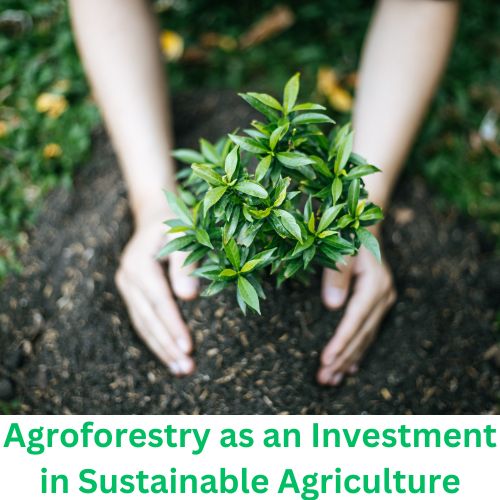“Foliage Finance: Agroforestry as an Investment in Sustainable Agriculture” delves into the potential of agroforestry as a sustainable investment strategy, aligning environmental stewardship with economic viability. This comprehensive examination highlights how integrating trees with agricultural practices can yield significant benefits for the environment and as a sound financial investment in the long term.
Introduction to Agroforestry
Agroforestry, the practice of integrating trees and shrubs into crop and animal farming systems, has been practiced for centuries. This approach offers a blend of the productivity of agriculture with the ecological benefits of forestry. Today, as the world faces environmental challenges like climate change and biodiversity loss, agroforestry presents itself as a sustainable solution, aligning ecological integrity with economic benefits.
The Economic Rationale for Agroforestry
Investing in agroforestry is not just an ecological or agricultural choice but also a financially sound decision. The diverse outputs from an agroforestry system – including timber, fruits, nuts, and other non-timber forest products – can provide multiple income streams. This diversification reduces risk and can lead to more excellent financial stability for farmers, especially in the face of market or climatic fluctuations.
Environmental Benefits and Their Economic Implications
Soil Health and Crop Yields: Trees improve soil health by enriching it with organic matter and protecting it against erosion. Healthier soils lead to better crop yields, directly promoting economic benefits.
Biodiversity and Ecosystem Services: Agroforestry supports biodiversity by providing habitats for various species. This biodiversity underpins ecosystem services like pollination and pest control, which are crucial for crop productivity.
Carbon Sequestration and Climate Change Mitigation: Trees absorb carbon dioxide, making agroforestry a tool for climate change mitigation. This has economic implications in the context of carbon credits and emerging markets for carbon trading.
The Role of Agroforestry in Sustainable Development
Agroforestry aligns with several United Nations Sustainable Development Goals (SDGs), including combating climate change, conserving ecosystems, and ensuring sustainable economic growth. Governments and private entities can contribute to these global goals by investing in agroforestry and potentially accessing green funding and subsidies.
Financial Mechanisms and Incentives for Agroforestry
To encourage the adoption of agroforestry, various financial mechanisms and incentives can be employed:
Grants and Subsidies: Governments and international organizations can offer grants and subsidies to support the initial costs of transitioning to agroforestry.
Microfinance and Loans: Access to microfinance and low-interest loans can empower smallholders to invest in agroforestry systems.
Carbon Credits: Farmers can benefit financially from carbon credits generated by their agroforestry projects, selling them in carbon markets.
Challenges in Agroforestry Investments
Despite its benefits, agroforestry faces challenges in attracting investment:
Long-Term Investment Horizon: Agroforestry often requires a longer time to yield financial returns than conventional agriculture, which can deter investors.
Knowledge and Training: Farmers need adequate knowledge and training to implement agroforestry effectively, which can entail additional costs.
Market Access and Value Chains: Developing markets for agroforestry products and establishing value chains are critical for ensuring profitable returns.
Case Studies: Success Stories of Agroforestry Investments
Coffee and Shade Trees in Central America: Integrating shade trees with coffee plantations has improved biodiversity, enhanced coffee quality, and provided additional income from timber.
Silvopastoral Systems in Europe: Combining forestry with livestock grazing has increased productivity and profitability while enhancing animal welfare and biodiversity.
Future of Agroforestry as a Financial Investment
The future of agroforestry as a financial investment is promising, with governments, financial institutions, and private investors increasingly recognizing its benefits. The growth of green finance and ethical investing trends also bodes well for agroforestry. Moreover, technological advancements like precision agriculture and remote sensing can optimize the management and productivity of agroforestry systems, making them more attractive to investors.
Conclusion
Agroforestry stands at the intersection of sustainable agriculture, environmental conservation, and economic viability. It represents an investment in our planet’s health and communities’ prosperity. For farmers, it offers a path to diversify and stabilize income; for investors, a chance to contribute to sustainable development; and for the global community, a step toward a more resilient and sustainable agricultural future. As the world increasingly recognizes the importance of sustainable practices, agroforestry emerges as a farm strategy and a viable investment in our collective future.
“The Green Canvas: Painting Sustainable Agriculture with Agroforestry”
In an era marked by climate change and environmental degradation, the need for sustainable agricultural practices has become more critical than ever before. Among the innovative and eco-friendly approaches gaining attention, agroforestry emerges as a promising canvas to paint a greener future for agriculture.
Agroforestry is a holistic land management system combining trees or woody perennials with crops and livestock on the same land. This practice has been employed for centuries across diverse cultures, but its relevance has been rediscovered as a sustainable solution to modern agricultural challenges.
The beauty of agroforestry lies in its multifaceted benefits. Firstly, it promotes biodiversity by creating diverse microenvironments supporting various plant and animal species. By blending different crops and trees, agroforestry enhances soil fertility and mitigates the risk of pests and diseases, reducing the need for chemical inputs.
Furthermore, agroforestry serves as a climate change warrior. Trees sequester carbon dioxide, helping combat greenhouse gas emissions. Trees in agroforestry systems provide shade and shelter for crops and livestock, reducing extreme temperatures and conserving water, particularly in arid regions.
The economic aspect of agroforestry is equally appealing. It diversifies income sources for farmers as they can harvest multiple products from the same piece of land. Timber, fruits, nuts, and non-timber forest products can be lucrative income streams, enhancing the resilience of farming communities.
Agroforestry, however, has its challenges. Implementing these systems requires careful planning, knowledge, and a long-term commitment. Farmers need support and resources to transition to agroforestry practices successfully.
